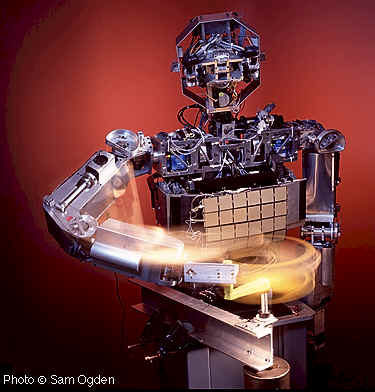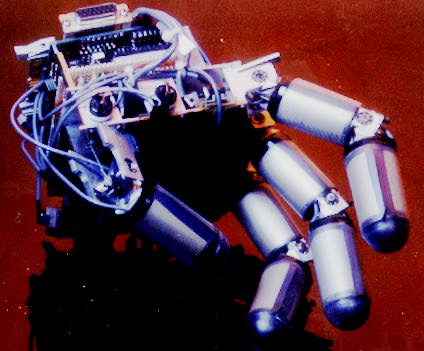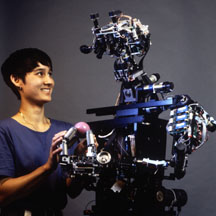|
An effector is any device that
affects the environment. Robots control their effectors, which are
also known as end effectors. Effectors include legs, wheels, arms,
fingers, wings and fins. Controllers cause the effectors to produce
desired effects on the environment. An actu ator
is the actual mechanism that enables the effector to execute an
action. Actuators typically include electric motors, hydraulic or
pneumatic cylinders, etc. The terms effector and actuator are often
used interchangeably to mean "whatever makes the robot take an
action." This is not really proper use. Actuators and effectos are not
the same thing. And we'll try to be more precise in the class. Most
simple actuators control a single degree of freedom, i.e., a
single motion (e.g., up-down, left-right, in-out, etc.). A motor shaft
controls one rotational degree of freedom, for example. A sliding part
on a plotter controls one translational degree of freedom. How many
degrees of freedom (DOF) a robot has is going to be very important in
determining how it can affect its world, and therefore how well, if at
all, it can accomplish its task. Just as we said many times before
that sensors must be matched to the robot's task, similarly,
effectors must be well matched to the robot's task also. ator
is the actual mechanism that enables the effector to execute an
action. Actuators typically include electric motors, hydraulic or
pneumatic cylinders, etc. The terms effector and actuator are often
used interchangeably to mean "whatever makes the robot take an
action." This is not really proper use. Actuators and effectos are not
the same thing. And we'll try to be more precise in the class. Most
simple actuators control a single degree of freedom, i.e., a
single motion (e.g., up-down, left-right, in-out, etc.). A motor shaft
controls one rotational degree of freedom, for example. A sliding part
on a plotter controls one translational degree of freedom. How many
degrees of freedom (DOF) a robot has is going to be very important in
determining how it can affect its world, and therefore how well, if at
all, it can accomplish its task. Just as we said many times before
that sensors must be matched to the robot's task, similarly,
effectors must be well matched to the robot's task also.
In
general, a free body in space as 6 DOF: three for translation (x,y,z),
and three for orientation/rotation (roll, pitch, and yaw). We'll go
back to DOF in a bit. You need to know, for a given effector (and
actuator/s), how many DOF are available to the robot, as well as how
many total DOF any given robot has. If there is an actuator for every
DOF, then all of the DOF are controllable. Usually not all DOF are
controllable, which makes robot control harder. A car has 3 DOF:
position (x,y) and orientation (theta). But only 2 DOF are
controllable: driving: through the gas pedal and the forward-reverse
gear; steering: through the steering wheel. Since there are more DOF
than are controllable, there are motions that cannot be done, like
moving sideways (that's why parallel parking is hard). We need to
make a distinction between what an actuator does (e.g., pushing the
gas pedal) and what the robot does as a result (moving forward). A car
can get to any 2D position but it may have to follow a very
complicated trajectory. Parallel parking requires a discontinuous
trajectory w.r.t. velocity, i.e., the car has to stop and go. When
the number of controllable DOF is equal to the total number of DOF on
a robot, it is holonomic(for more information about holonomic). If the number of controllable DOF is smaller than total DOF,
the robot is non-holonomic. If the number of controllable DOF is
larger than the total DOF, the robot is redundant. A human arm has 7
DOF (3 in the shoulder, 1 in the elbow, 3 in the wrist), all of which
can be controlled. A free object in 3D space (e.g., the hand, the
finger tip) can have at most 6 DOF! So there are redundant ways of
putting the hand at a particular position in 3D space. This is the
core of why manipulations is very hard!
Two basic ways of using effectors:
These divide robotics into two mostly separate
categories:
-
mobile robotics
-
manipulator robotics
Mobility end effectors are discussed in more detail in the
mobility section of this web site.
In contrast to locomotion, where the body of the robot is moved
to get to a particular position and orientation, a manipulator moves
itself typically to get the end effector (e.g., the hand, the
finger, the fingertip) to the desired 3D position and orientation. So
imagine having to touch a specific point in
 3D space with the tip of your index finger; that's what a typical
manipulator has to do. Of course, largely manipulators need to grasp
and move objects, but those tasks are extensions of the basic reaching
above. The challenge is to get there efficiently and safely. Because
the end effector is attached to the whole arm, we have to worry about
the whole arm; the arm must move so that it does not try to violate
its own joint limits and it must not hit itself or the rest
of the robot, or any other obstacles in the environment. Thus, doing
autonomous manipulation is very challenging. Manipulation was first
used in tele-operation, where human operators would move artificial
arms to handle hazardous materials. It turned out that it was quite
difficult for human operators to learn how to tele-operate complicated
arms (such as duplicates of human arms, with 7 DOF). One alternative
today is to put the human arm into an exo-skeleton (see lecture 1), in
order to make the control more direct. Using joy-sticks, for example,
is much harder for high DOF. Why is this so hard? Because even as we
saw with locomotion, there is typically no direct and obvious link
between what the effector needs to do in physical space and what the
actuator does to move it. In general, the correspondence between
actuator motion and the resulting effector motion is called
kinematics. In order to control a manipulator, we have to know
its kinematics (what is attached to what, how many joints there are,
how many DOF for each joint, etc.). We can formalize all of this
mathematically, and get an equation which will tell us how to convert
from, say, angles in each of the joints, to the Cartesian positions of
the end effector/point. This conversion from one to the other is
called computing the manipulator kinematics and inverse kinematics.
3D space with the tip of your index finger; that's what a typical
manipulator has to do. Of course, largely manipulators need to grasp
and move objects, but those tasks are extensions of the basic reaching
above. The challenge is to get there efficiently and safely. Because
the end effector is attached to the whole arm, we have to worry about
the whole arm; the arm must move so that it does not try to violate
its own joint limits and it must not hit itself or the rest
of the robot, or any other obstacles in the environment. Thus, doing
autonomous manipulation is very challenging. Manipulation was first
used in tele-operation, where human operators would move artificial
arms to handle hazardous materials. It turned out that it was quite
difficult for human operators to learn how to tele-operate complicated
arms (such as duplicates of human arms, with 7 DOF). One alternative
today is to put the human arm into an exo-skeleton (see lecture 1), in
order to make the control more direct. Using joy-sticks, for example,
is much harder for high DOF. Why is this so hard? Because even as we
saw with locomotion, there is typically no direct and obvious link
between what the effector needs to do in physical space and what the
actuator does to move it. In general, the correspondence between
actuator motion and the resulting effector motion is called
kinematics. In order to control a manipulator, we have to know
its kinematics (what is attached to what, how many joints there are,
how many DOF for each joint, etc.). We can formalize all of this
mathematically, and get an equation which will tell us how to convert
from, say, angles in each of the joints, to the Cartesian positions of
the end effector/point. This conversion from one to the other is
called computing the manipulator kinematics and inverse kinematics.
The process of converting the Cartesian (x,y,z) position into a
set of joint angles for the arm (thetas) is called inverse kinematics.
Kinematics are the rules of what is attached to what, the body
structure. Inverse kinematics is computationally intense. And the
problem is even harder if the manipulator (the arm) is redundant.
Manipulation involves
Manipulators are effectors. Joints connect
parts of manipulators. The most common joint types are:
These joints provide the DOF for an effector, so
they are planned carefully.
Robot manipulators can have one or more of each of those
joints. Now recall that any free body has 6 DOF; that means in order
to get the robot's end effector to an arbitrary position and
orientation, the robot requires a minimum of 6 joints. As it turns
out, the human arm (not counting the hand!) has 7 DOF. That's
sufficient for reaching any point with the hand, and it is also redundant, meaning that there are multiple ways in which any point can
be reached. This is good news and bad news; the fact that there are
multiple solutions means that there is a larger space to search
through to find the best solution. Now consider end effectors. They
can be simple pointers (i.e., a stick), simple 2D grippers,
screwdrivers for attaching tools (like welding guns, sprayer, etc.),
or can be as complex as the human hand, with variable numbers of
fingers and joints in the fingers. Problems like reaching and
grasping in manipulation constitute entire subareas of robotics and
AI. Issues include: finding grasp-points (COG, friction, etc.);
force/strength of grasp; compliance (e.g., in sliding, maintaining
contact with a surface); dynamic tasks (e.g., juggling, catching).
Other types of manipulation, such as carefully controlling force, as
in grasping fragile objects and maintaining contact with a surface
(so-called compliant motion), are also being actively
researched. Finally, dynamic manipulation tasks, such as juggling,
throwing, catching, etc., are already being demonstrated on robot
arms.
redundant, meaning that there are multiple ways in which any point can
be reached. This is good news and bad news; the fact that there are
multiple solutions means that there is a larger space to search
through to find the best solution. Now consider end effectors. They
can be simple pointers (i.e., a stick), simple 2D grippers,
screwdrivers for attaching tools (like welding guns, sprayer, etc.),
or can be as complex as the human hand, with variable numbers of
fingers and joints in the fingers. Problems like reaching and
grasping in manipulation constitute entire subareas of robotics and
AI. Issues include: finding grasp-points (COG, friction, etc.);
force/strength of grasp; compliance (e.g., in sliding, maintaining
contact with a surface); dynamic tasks (e.g., juggling, catching).
Other types of manipulation, such as carefully controlling force, as
in grasping fragile objects and maintaining contact with a surface
(so-called compliant motion), are also being actively
researched. Finally, dynamic manipulation tasks, such as juggling,
throwing, catching, etc., are already being demonstrated on robot
arms.
Having talked about navigation and manipulation, think about
what types of sensors (external and proprioceptive) would be useful
for these general robotic tasks. Proprioceptive sensors sense
the robot's actuators (e.g., shaft encoders, joint angle sensors,
etc.); they sense the robot's own movements. You can think of them as
perceiving internal state instead of external state. External sensors
are helpful but not necessary or as commonly used. |